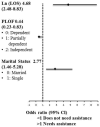Predicting discharge placement and health care needs after lumbar spine laminectomy
- PMID: 24925036
- PMCID: PMC4679198
Predicting discharge placement and health care needs after lumbar spine laminectomy
Abstract
Objective: To explore factors associated with discharge placement (DP) and need for skilled assistance after patients are discharged from hospital following lumbar laminectomy.
Methods: A retrospective analysis of 339 patients who underwent lumbar laminectomy was conducted. We used multivariable logistic regression analysis to identify significant covariates and to construct two regression models: a primary model to predict DP, home vs inpatient rehabilitation/skilled nursing facility (IR/SNF), and a secondary model to predict the need for skilled assistance once patients are discharged to home.
Results: The sample included 48.7% females, 68.2% married, 56.3% independent in daily activities, and 85.2% discharged to home. Subjects were a mean 56.06 ± 12.75 years old and had a BMI of 31.35 ± 6.2. Of those discharged to home, 17.7% needed skilled assistance. Patients stayed 4.41 ± 3.55 days in the hospital and walked 203.38 ± 144.87 ft during hospital stay. Age, distance walked during hospital stay, and length of hospital stay (LOS) were significant positive predictors for discharge to home vs IR/SNF, whereas single living status, diminished prior level of function, and longer LOS were predictors of need for skilled assistance after discharge to home.
Conclusion: Age, mobility, marital status, prior level of function, and LOS are key variables in determining healthcare needs following lumbar laminectomy.
Conflict of interest statement
No duality of interest to declare.
Figures



References
-
- Deyo RA. Trends and variations in the use of spine surgery. Orthop Related Research. 2006;443:139–146. - PubMed
-
- Schiller J, Lucas J, Ward B, Peregoy J. Summary health statistics for U.S. adults: National Health Interview Survey, 2010. National Center for Health Statistics. Vital Health Stat. 2012;252(10) - PubMed
-
- Ostelo RW, de Vet HC, Waddell G, et al. Rehabilitation following first-time lumbar disc surgery: a systematic review within the framework of the cochrane collaboration. Spine (Phila Pa 1976) 2003;28(3):209–218. - PubMed
-
- Cherkin DC, Deyo RA, Loeser JD, et al. An international comparison of back surgery rates. Spine (Phila Pa 1976) 1994;19(11):1201–1206. - PubMed
Publication types
MeSH terms
Grants and funding
LinkOut - more resources
Full Text Sources
Medical
